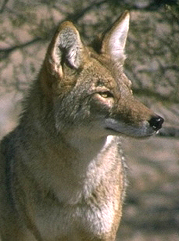

In their stories, Native Americans call him the prankster, and he is considered an animal of wisdom and insight. A survivor of the extinctions at the end of the Ice Age, he since has spread throughout North America. Nevertheless, for many people, the cry of this multi-voiced ventriloquist, echoing through the night, epitomizes the West as does no other animal.
The coyote has continued to thrive despite the persecution continually
tracking his paw prints in the form of ranchers, farmers, and bounty hunters who have
used every method short of atomic warfare in the attempt to eradicate this resourceful
creature. A member of the dog family, the coyote's combination of adaptability in
habitat and diet, and its brilliant evasiveness has allowed him to live in a variety of
places ranging from the wild reaches of the West to suburban areas of large cities.
Combined with a tenacious will to survive, these traits seem to ensure the coyote's
continuing existence. Perhaps his crowning prank is a figurative thumbing of the nose
to those who would rein in this free spirit.

Contributor: Suzanne Kilbourne, Student, University of Texas at El Paso.
Desert Diary is a joint production of the Centennial Museum and KTEP National Public Radio at the University of Texas at El Paso.

Coyote (Canis latrans). Photographer: Dr. Lloyd Glenn Ingles, © 1999 California Academy of Sciences.
Kays, R. W., and D. E. Wilson. 2002. Mammals of North America. Princeton University Press, Princeton. 240 pp.